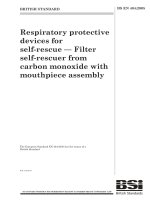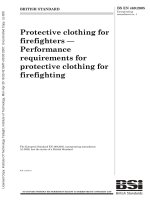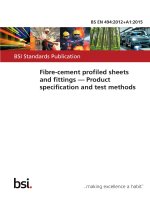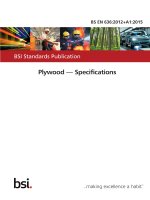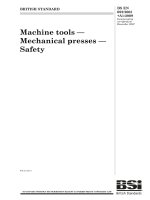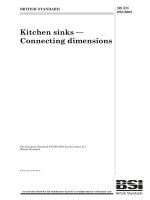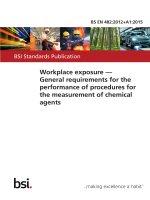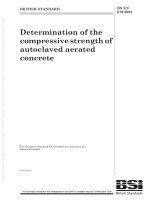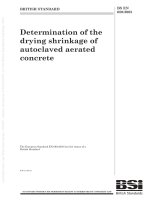Bsi bs en 62115 2005 + a12 2015
Bạn đang xem bản rút gọn của tài liệu. Xem và tải ngay bản đầy đủ của tài liệu tại đây (1.46 MB, 68 trang )
BRITISH STANDARD BS EENN
62111155::22000055
Electric toys — Safety +A1112::22001125
Incorporating
corrigendaa
JJuullyy 22001100 aanndd
NNoovveemmbbeerr 22001111
ICS 97.200.50; 13.120
12 &23<,1* :,7+287 %6, 3(50,66,21 (;&(37 $6 3(50,77(' %< &23<5,*+7 /$:
BS EN 62115:2005+A12:2015
National foreword
This British Standard is the UK implementation of EN 62115:2005+A12:2015.
It is derived from IEC 62115:2003, incorporating amendments 1:2004 and
2:2010. It supersedes BS EN 62115:2005+A11:2012 which will be withdrawn on
03 June 2017.
The CENELEC common modifications have been implemented at the
appropriate places in the text. The start and finish of each common modification
is indicated in the text by tags . Where a common modification has been
introduced by amendment, the tags carry the number of the amendment. For
example, the common modifications introduced by CENELEC amendment A11
are indicated by .
The start and finish of text introduced or altered by IEC amendment is
indicated in the text by tags. Tags indicating changes to IEC text carry the
number of the IEC amendment. For example, text altered by IEC amendment 1
is indicated by .
National Annex NA (informative) reproduces CENELEC interpretation sheet 1
(March 2010).
The UK participation in its preparation was entrusted by Technical Committee
CPL/61, Safety of household and similar electrical appliances, to Subcommittee
CPL/61/21, Toys.
A list of organizations represented on this subcommittee can be obtained on
request to its secretary.
The publication does not purport to include all the necessary provisions of a
contract. Users are responsible for its correct application.
Compliance with a British Standard cannot confer immunity from
legal obligations.
This British Standard was Amendments/corrigenda issued since publication
published under the authority
of the Standards Policy and Date Comments
Strategy Committee 31 July 2010
on 1 August 2005 Addition of CENELEC interpretation sheet 1
30 September 2011 (March 2010) in National Annex NA
© The British Standards
Institution 2015. 30 November 2011 Implementation of IEC amendment 2:2010 with
Published by BSI Standards 31 December 2012 CENELEC modifications
Limited 2015 31 January 2015
Correction to amendment A2 text in 7.4
ISBN 978 0 580 85336 4
Implementation of CENELEC amendment A11:2012
Implementation of CENELEC amendment A12:2015
EUROPEAN STANDARD EN 62115:2005+A121
NORME EUROPÉENNE
EUROPÄISCHE NORM JSaenputeamryb2e0r125012
ICS 97.200.50; 13.120 English version
Electric toys –
Safety
(IEC 62115:2003 + A1:2004, modified)
Jouets électriques – Elektrische Spielzeuge –
Sécurité Sicherheit
(CEI 62115:2003 + A1:2004, modifiée) (IEC 62115:2003 + A1:2004, modifiziert)
This European Standard was approved by CENELEC on 2004-12-07. CENELEC members are bound to
comply with the CEN/CENELEC Internal Regulations which stipulate the conditions for giving this European
Standard the status of a national standard without any alteration.
Up-to-date lists and bibliographical references concerning such national standards may be obtained on
application to the Central Secretariat or to any CENELEC member.
This European Standard exists in three official versions (English, French, German). A version in any other
language made by translation under the responsibility of a CENELEC member into its own language and
notified to the Central Secretariat has the same status as the official versions.
CENELEC members are the national electrotechnical committees of Austria, Belgium, Cyprus, Czech
Republic, Denmark, Estonia, Finland, France, Germany, Greece, Hungary, Iceland, Ireland, Italy, Latvia,
Lithuania, Luxembourg, Malta, Netherlands, Norway, Poland, Portugal, Slovakia, Slovenia, Spain, Sweden,
Switzerland and United Kingdom.
CENELEC European Committee for Electrotechnical Standardization
Comité Européen de Normalisation Electrotechnique
Europäisches Komitee für Elektrotechnische Normung
Central Secretariat: rue de Stassart 35, B - 1050 Brussels
© 2005 CENELEC - All rights of exploitation in any form and by any means reserved worldwide for CENELEC members.
Ref. No. EN 62115:2005 E
BS EN 62115:2005+A121:20152 –2- 2– -
EN 62115:2005+A121:20152 (E)
Foreword
During the Copenhagen meeting in May 2003, the CENELEC Technical Committee TC 61 decided to
submit the text of the International Standard IEC 62115:2003, prepared by IEC TC 61, to the Unique
Acceptance Procedure together with CENELEC common modifications.
The text of the draft common modifications, circulated in March 2004, included the content of the future
amendment 1 to IEC 62115:2003. In view of the publication of this amendment in IEC, the relevant
common modifications have been deleted and amendment 1:2004 to IEC 62115:2003 has been included
in the European Standard which was approved by CENELEC as EN 62115 on 2004-12-07.
This European Standard replaces EN 50088:1996 + A1:1996 + A2:1997 + corrigenda April 2001 +
A3:2002.
The following dates were fixed:
- latest date by which the EN has to be implemented (dop) 2006-01-01
at national level by publication of an identical
national standard or by endorsement
- date on which national standards (dow) 2008-01-01
conflicting with the EN have to be withdrawn
This European Standard has been prepared under a mandate given to CENELEC by the European
Commission and the European Free Trade Association and covers essential requirements of
EC Directive 88/378/EEC. See Annex ZZ.
NOTE The following print types are used:
- requirements: in roman type;
- test specifications: in italic type;
- notes: in small roman type.
Words in bold in the text are defined in Clause 3. When a definition concerns an adjective, the adjective and the associated noun
are also in bold.
There are no special national conditions causing a deviation from this European Standard.
There are no national deviations from this European Standard.
Annexes ZA and ZZ have been added by CENELEC.
p NOTE In this document, p is used in the margin to indicate instructions for preparing the printed version.
_______________
Endorsement notice
The text of the International Standard IEC 62115:2003 + A1:2004 was approved by CENELEC as a European
Standard with agreed common modifications.
–3- –3 - BS EN 62115:2005+A112:20125
EENN 66221115:2005+A112:20125 (E)
Foreword to amendment A2
The text of document 61/4051/FDIS, future edition 1 of IEC 62115:2003/A2:2010, prepared by IEC TC 61,
Safety of household and similar electrical appliances, was submitted to the IEC-CENELEC parallel vote.
A draft amendment, prepared by the Technical Committee CENELEC TC 61, Safety of household and
similar electrical appliances, was submitted to the formal vote.
The combined texts were approved by CENELEC as EN 62115:2005/A2:2011 on 2011-01-02.
The following dates were fixed:
– latest date by which the amendment has to be implemented (dop) 2012-01-02
at national level by publication of an identical
national standard or by endorsement
– latest date by which the national standards conflicting (dow) 2014-01-02
with the amendment have to be withdrawn
This amendment has been prepared under Mandate M/445 given to CENELEC by the European
Commission and the European Free Trade Association to cover Essential Requirements of EC Directive
2009/48/EC. (see Annex ZZ).
NOTE 1 The following print types are used:
- requirements: in roman type;
- test specifications: in italic type;
- notes: in small roman type.
Words in bold in the text are defined in Clause 3. When a definition concerns an adjective, the adjective and the associated noun
are also in bold.
p NOTE 2 In this document, p is used in the margin to indicate instructions for preparing the printed version.
Annexes ZA and ZZ have been added by CENELEC.
__________
Endorsement notice
The text of the International Standard IEC 62115:2003/A2:2010 was approved by CENELEC as a
European Standard with agreed common modifications.
BS EN 62115:2005+A121:20152 –4- 4– -
EN 62115:2005+A121:20152 (E)
Foreword to amendment A11
This document (EN 62115:2005/A11:2012) has been prepared by CLC/TC 61 "Safety of household and
similar electrical appliances".
The following dates are fixed:
– latest date by which this document has to be implemented (dop) 2013-06-04
at national level by publication of an identical national
standard or by endorsement
– latest date by which the national standards conflicting with (dow) 2015-06-04
this document have to be withdrawn
Attention is drawn to the possibility that some of the elements of this document may be the subject of
patent rights. CENELEC [and/or CEN] shall not be held responsible for identifying any or all such patent
rights.
This A11 has been developed to answer the concerns expressed by the European Commission regarding
EN 62115:2005 and its links with M/445 and the Toys Directive 2009/48/EC (see D136/061 and
BT136/DG8024/DC).
This document has been prepared under a mandate given to CENELEC by the European Commission
and the European Free Trade Association, and supports essential requirements of EU Directive.
For the relationship with EU Directive 2009/48/EC, see informative Annexes ZZA and ZZB, which are an
integral part of this document.
Clauses, subclauses, notes, tables and figures which are additional to those in IEC 62115:2003 +
A1:2004+ A2:2010 are prefixed “Z”.
NOTE The following print types are used:
– requirements: in roman type;
– test specifications: in italic type;
– notes: in small roman type.
Words in bold in the text are defined in Clause 3. When a definition concerns an adjective, the adjective and the
associated noun are also in bold.
- 3 - EN 62115:2005/A12:2015
- 5 -
BS EN 62115:2005+A12:2015
EN 62115:2005+A12:2015 (E)
Foreword Foreword to amendment A12
This document (EN 62115:2005/A12:2015) has been prepared by CLC/TC 61 "Safety of household and
similar electrical appliances".
The following dates are fixed:
– latest date by which this document has to be implemented (dop) 2015-07-09
at national level by publication of an identical national
standard or by endorsement
– latest date by which the national standards conflicting with (dow) 2017-06-03
this document have to be withdrawn
Attention is drawn to the possibility that some of the elements of this document may be the subject of
patent rights. CENELEC [and/or CEN] shall not be held responsible for identifying any or all such patent
rights.
This document has been prepared under a mandate given to CENELEC by the European Commission
and the European Free Trade Association, and supports essential requirements of EU Directive(s).
For the relationship with EU Directive 2009/48/EC, see informative Annexes ZZA and ZZB, which are an
integral part of this document.
Clauses, subclauses, notes, tables and figures which are additional to those in IEC 62115:2003 +
A1:2004 + A2:2010 are prefixed “Z”.
NOTE The following print types are used:
– requirements: in roman type;
– test specifications: in italic type;
– notes: in small roman type.
Words in bold in the text are defined in Clause 3. When a definition concerns an adjective, the adjective and the
associated noun are also in bold.
BS EN 62115:2005+A12:2015 –5- 6– - BS EN 62115:2005+A11:2012
EN 62115:2005+A12:2015 (E) EN 62115:2005+A11:2012 (E)
h Annex ZA
(normative)
Normative references to international publications
with their corresponding European publications
The following documents, in whole or in part, are normatively referenced in this document and are
indispensable for its application. For dated references, only the edition cited applies. For undated
references, the latest edition of the referenced document (including any amendments) applies.
NOTE When an International Publication has been modified by common modifications, indicated by (mod), the relevant EN/HD
applies.
Publication Year Title EN/HD Year
– – Safety of toys EN 71-1 –
IEC 60068-2-75 1997 Part 1: Mechanical and physical properties EN 60068-2-75 1997
IEC 60083 – Environmental testing – –
IEC 60086-2 – Part 2-75: Tests - Test Eh: Hammer tests EN 60086-2 –
IEC 60335-1 2010 Plugs and socket-outlets for domestic and EN 60335-1 2012
IEC 60335-2-29 2002 similar general use standardized in member
+ A1 2004 countries of IEC EN 60335-2-29 2004
+ A2 2009 Primary batteries + A2 2010
IEC 60384-14 – Part 2: Physical and electrical specifications EN 60384-14 –
Household and similar electrical appliances -
IEC 60417-11) – Safety – –
IEC 60529 1989 Part 1: General requirements EN 60529 1991
– – Household and similar electrical appliances - + corr. May 1993
+ A1 1999 Safety + A1 2000
Part 2-29: Particular requirements for
battery chargers
Fixed capacitors for use in electronic
equipment
Part 14: Sectional specification:
Fixed capacitors for electromagnetic
interference suppression and connection to
the supply mains
Graphical symbols for use on equipment
Part 1: Overview and application
Degrees of protection provided by
enclosures (IP Code)
IEC 60695-2-11 – Fire hazard testing EN 60695-2-11 –
Part 2-11: Glowing/hot-wire based test
methods - Glow-wire flammability test
method for end-products
IEC 60695-2-13 – Fire hazard testing EN 60695-2-13 –
Part 2-13: Glowing/hot-wire based test
methods - Glow-wire ignition temperature
(GWIT) test method for materials
1) Superseded by IEC 60417 database.i
BS EN 62115:2005+A11:2012 –6- –7 - BS EN 62115:2005+A12:2015
EN 62115:2005+A11:2012 (E) EN 62115:2005+A12:2015 (E)
hPublication Year Title EN/HD Year
IEC 60695-10-2 – Fire hazard testing EN 60695-10-2 –
IEC 60695-11-5 2004 Part 10-2: Abnormal heat - Ball pressure test EN 60695-11-5 2005
Fire hazard testing
IEC 60695-11-10 – Part 11-5: Test flames - Needle-flame test EN 60695-11-10 –
IEC 60730 series method - Apparatus, confirmatory test EN 60730 series
IEC 60738-1 – arrangement and guidance EN 60738-1 –
IEC 60825-1 1993 Fire hazard testing EN 60825-1 19942)
- - Part 11-10: Test flames - 50 W horizontal + corr. Feb. 1995
+ A1 1997 and vertical flame test methods + A1 2002
+ A2 2001 Automatic electrical controls for household + A2 2001
IEC 60990 1999 and similar use + corr. Apr. 2004
IEC 61000-4-2 – Thermistors - Directly heated positive EN 60990 1999
temperature coefficient EN 61000-4-2 –
IEC 61000-4-3 – Part 1: Generic specification
Safety of laser products EN 61000-4-3 –
IEC 61000-4-4 – Part 1: Equipment classification,
requirements and user's guide EN 61000-4-4 –
IEC 61000-4-5 –
IEC 61000-4-6 – Methods of measurement of touch current EN 61000-4-5 –
and protective conductor current EN 61000-4-6 –
IEC 61000-4-11 2004 Electromagnetic compatibility (EMC)
Part 4-2: Testing and measurement EN 61000-4-11 2004
techniques - Electrostatic discharge
immunity test
Electromagnetic compatibility (EMC)
Part 4-3: Testing and measurement
techniques - Radiated, radio-frequency,
electromagnetic field immunity test
Electromagnetic compatibility (EMC)
Part 4-4: Testing and measurement
techniques - Electrical fast transient/burst
immunity test
Electromagnetic compatibility (EMC)
Part 4-5: Testing and measurement
techniques - Surge immunity test
Electromagnetic compatibility (EMC)
Part 4-6: Testing and measurement
techniques - Immunity to conducted
disturbances, induced by radio-frequency
fields
Electromagnetic compatibility (EMC)
Part 4-11: Testing and measurement
techniques - Voltage dips, short interruptions
and voltage variations immunity tests
2) EN 60825-1:1993 and its amendments are superseded by EN 60825-1:2007, which is based on IEC 60825-1:2007 and by
EN 62471:2008, which is based on IEC 62471:2006. However, for LEDs in toys a product standard based on ICNIRP
Recommendations is in preparation and therefore EN 60825-1:1993 and its amendments will have to be used until this standard for
LEDs in toys is implemented.i
BS EN 62115:2005+A12:2015 –7- 8– - BS EN 62115:2005+A11:2012
EN 62115:2005+A12:2015 (E) EN 62115:2005+A11:2012 (E)
hPublication Year Title EN/HD Year
IEC 61000-4-13 – Electromagnetic compatibility (EMC) EN 61000-4-13 –
Part 4-13: Testing and measurement
IEC 61032 1997 techniques - Harmonics and interharmonics EN 61032 1998
IEC 61058-1 (mod) 2000 including mains signalling at a.c. power port, EN 61058-1 2002
+ A1 2001 low frequency immunity tests + A2 2008
+ A2 2007 Protection of persons and equipment by EN 61180-1 –
IEC 61180-1 – enclosures - Probes for verification EN 61558-2-6 –
IEC 61558-2-6 – Switches for appliances
Part 1: General requirements EN 61558-2-7 –
IEC 61558-2-7 – EN 61558-2-16 –
IEC 61558-2-16 – High-voltage test techniques for low-voltage
equipment EN 62233 2008
IEC 62233 (mod) 2005 Part 1: Definitions, test and procedure + corr. Aug. 2008
ISO 7000 – requirements – –
ISO 9772 – Safety of transformers, reactors, power – –
supply units and similar products for supply
voltages up to 1 100 V
Part 2-6: Particular requirements and tests
for safety isolating transformers and power
supply units incorporating safety isolating
transformers
Safety of power transformers, power supply
units and similar
Part 2-7: Particular requirements for
transformers for toys
Safety of transformers, reactors, power
supply units and similar products for supply
voltages up to 1 100 V
Part 2-16: Particular requirements and tests
for switch mode power supply units and
transformers for switch mode power supply
units
Measurement methods for electromagnetic
fields of household appliances and similar
apparatus with regard to human exposure
Graphical symbols for use on equipment -
Registered symbols
Cellular plastics - Determination of horizontal
burning characteristics of small specimens
subjected to a small flamei
BS EN 62115:2005+A11:2012 –8- –9 - BS EN 62115:2005+A12:2015
EN 62115:2005+A11:2012 (E) EN 62115:2005+A12:2015 (E)
h Annex ZB
(normative)
Toys with protective electronic circuit
If during the tests of 9.8 an electronic circuit prevents the hazardous conditions listed in 9.9 or
dangerous malfunction, it shall additionally comply with the following requirements. In this case, the
electronic circuit is considered as a protective electronic circuit. For toys with a protective
electronic circuit, the following requirement is therefore applicable in addition to Clause 9.
9.ZB The toy shall not malfunction in such a way as to cause an unintended operation that may impair
safety or present a dangerous malfunction due to influence from electromagnetic phenomena (EMP).
Compliance is checked by the test of 9.ZB.1 and 9.ZB.2. Transformer toys and dual-supply toys
incorporating a protective electronic circuit are additionally subjected to the tests of 9.ZB.3 to 9.ZB.7,
using the supplied or the recommended transformer for toys. The tests are carried out under the
following conditions.
The tests are carried out with the toy supplied at rated voltage and the toy operated in the following
modes:
– electronic off mode;
– stand-by mode;
– operating mode.
NOTE If the toy has several modes of operation, the tests are carried out with the toy operating in each mode if necessary.
The tests are carried out after the protective electronic circuit has operated during the fault conditions
of 9.8.2.
The tests are carried out with surge arresters disconnected, unless they incorporate spark gaps.
Toys incorporating electronic controls complying with the EN 60730 series are not exempt from the tests.
If the protective electronic circuit includes only passive electronic components such as positive
temperature co-efficient (PTC) resistors, negative temperature co-efficient (NTC) resistors or voltage
dependent resistors (VDRs), the tests of Annex ZB are not applied.
9.ZB.1 The toy is subjected to electrostatic discharges in accordance with EN 61000-4-2, test level 4
being applicable. Ten discharges having a positive polarity and ten discharges having a negative polarity
are applied at each preselected point.
9.ZB.2 The toy is subjected to radiated fields in accordance with EN 61000-4-3, test level 3 being
applicable.
NOTE The dwell time for each frequency is to be sufficient to observe a possible malfunction of the protective electronic
circuit.
9.ZB.3 The toy is subjected to fast transient bursts in accordance with EN 61000-4-4. Test level 3 is
applicable for signal and control lines. Test level 4 is applicable for the power supply lines. The bursts are
applied for 2 min with a positive polarity and for 2 min with a negative polarity.
9.ZB.4 The power supply terminals of the toy are subjected to voltage surges in accordance with
EN 61000-4-5, five positive impulses and five negative impulses being applied at the selected points. Test
level 3 is applicable for the line-to-line coupling mode, a generator having a source impedance of 2 Ω
being used. Test level 4 is applicable for the line-to-earth coupling mode, a generator having a source
impedance of 12 Ω being used.
For toys having surge arresters incorporating spark gaps, the test is repeated at a level that is 95 % of
the flashover voltage.i
BS EN 62115:2005+A12:2015 –-91–0 - BS EN 62115:2005+A11:2012
EN 62115:2005+A12:2015 (E) EN 62115:2005+A11:2012 (E)
h9.ZB.5 The toy is subjected to injected currents in accordance with EN 61000-4-6, test level 3 being
applicable. During the test, all frequencies between 0,15 MHz to 80 MHz are covered.
NOTE The dwell time for each frequency is to be sufficient to observe a possible malfunction of the protective electronic
circuit.
9.ZB.6 The toy is subjected to voltage dips and interruptions in accordance with EN 61000-4-11. The
durations specified in EN 61000-4-11:2004, Table 1, are applied to each test level, the dips and
interruptions being applied at zero crossing of the supply voltage.
9.ZB.7 The toy is subjected to mains signals in accordance with EN 61000-4-13, test level class 2 being
applicable.i - 5 - EN 62115:2005/A12:2015
Annex ZC
(normative)
Toys generating Electromagnetic Fields (EMF)
Toys with an integrated field source generating EMF shall comply with EN 62233:2008 with the following
modifications.
In EN 62233:2008, Clause A.1 "General", add the following:
Toys without a motor, inductor or which only include passive electronic components, are considered to
comply with this requirement without measurement. The requirements do not apply to parts of toys
consuming a current of 3 A or less.
The current is checked by measurement during the tests of EN 62115:2005, 9.3, unless the construction
of the toy is such that the current cannot exceed 3 A.
In EN 62233:2008, A.2.3 "Measuring distances and sensor location", add the following to Table A.1,
before the row for "Tumble dryers":
Toys or parts of toys, 0 All surfaces Continuously 0,18
intended to be used Continuously
close to the body 15 All surfaces Continuously 0,18
0,18
Toys or parts of toys, 30 All surfaces
hand-held
Toys or parts of toys,
other
BS EN 62115:2005+A11:2012 –1-011– - BS EN 62115:2005+A12:2015
EN 62115:2005+A11:2012 (E) EN 62115:2005+A12:2015 (E)
h Annex ZZA
(informative)
Coverage of Essential Requirements of the EU Directives
This European standard has been prepared under a mandate given to CENELEC by the European
Commission and the European Free Trade Association to provide a means of conforming to Essential
Requirements of the New Approach Directive 2009/48/EC that relate to Electrical properties within the
scope of the standard.
Compliance with this standard provides one means of conformity with the specified Particular Safety
Requirements of the directive given in Annex II, Section IV, Electrical Properties.
The cross-references between the clauses of the standard and the Essential Requirements of the directive
aErNe 6g2iv1e1n5:2be0l0o5w/Aa1n2d:20th1e5 background and justifica-ti6on- for the requirements of the standard is given in
Annex ZZB.
Other requirements and other EU Directives may be applicable to the products falling within the scope of
this standard.
Annex ZZA
EXAMPLE The relevant requirements of EN 71 series. (informative)
This European SCtaonvdearrdagdoeesofnoEtscsonefnertiaanlyRpereqsuumirpetmionenoftscoonffotrhmeityEoUn tDhoirseecptairvtiecuslar requirements
not listed in Table ZZA.1.
Table ZZA.1
Replace Table ZZA.1 with the following updated table:
Clause(s)/sub-clause(s) of this European Standard Particular requirements of
Particular requirements of
Clause(s)/sub-clause(s) of this European Standard
Directive 2009/48/EC,
Directive 2009/48/EC,
Annex II
Annex II
14.1, 14.15 IV 1.
14.1, 14.15 IV 1.
8, 14.1, 14.2, 14.3, 14.4, 14.10, 14.15, 14.Z1, 15.1, 15.2, 16.3, 16.4, IV 2.
8, 14.1, 14.2, 14.3, 14.4, 14.10, 14.15, 14.Z1, 15.1, 15.2, 16.3, 16.4, IV 2.
17.1, 17.2, 18, Annex A 14.1, 15
17.1, 17.2, 18, Annex A 14.1, 15
8, 9.1, 9.2, 9.3, 9.4, 9.5, 9.6, 9.7, 9.8, 9.9, 10, 14.5, 14.7, 14.9, 14.11, IV 3.
8, 9.1, 9.2, 9.3, 9.4, 9.5, 9.6, 9.7, 9.8, 9,9,10, 14.5, 14.7, 14.9, 14.11, IV 3.
14.12, 14.13, 16.1, 16.2, 16.3, 16.4, 17.1, 17.2, 18
14.12, 14.13, 16.1, 16.2, 16.3, 16.4, 17.1, 17.2, 18
8, 9.1, 9.2, 9.4, 9.5, 9.6, 9.7, 9.8, 9.9, 10, 11.1, 11.2, 14.5, 14.8, 14.9, IV 4.
8, 9.1, 9.2, 9.4, 9.5, 9.6, 9.7, 9.8, 9.9, 10, 11.1, 11.2, 14.5, 14.8, 14.9, IV 4.
14.Z1, 16.1, 16.2
14.Z1, 16.1, 16.2
8, 9.1, 9.2, 9.3, 9.4, 9.5, 9.6, 9.7, 9.8, 9.9, 10, 13, 14.5, 14.9, 14.10, 14.11, IV 5.
8, 9.1, 9.2, 9.3, 9.4, 9.5, 9.6, 9.7, 9.8, 9.9, 10, 13, 14.5, 14.9, 14.10, 14.11, IV 5.
14.12, 17.1 17.2, 19.1, 19.2, Annex B
14.12, 17.1 17.2, 19.1, 19.2, Annex B
9.1, 9.8, 9.9, Annex ZB IV 7.
20, Annex ZC IV 6.
20, Annex E 20 IV 8.
9.1, 9.8, 9.9, Annex ZB IV 7.
14.2 IV 9.
20, Annex E 20 IV 8.
NOTE 1 The requirements in Clauses 3, 5 and 7 are to be used in addition to the above clauses and sub-clauses.
14.2 IV 9.
NOTE 2 Other requirements and other EU Directives may be applicable to the product(s) falling within the scope of this European
Standard.
i
NOTE 1 The requirements in Clauses 3, 5 and 7 are to be used in addition to the above clauses and sub-clauses.
NOTE 2 Other requirements and other EU Directives may be applicable to the product(s) falling within the scope of this European
Standard.
BS EN 62115:2005+A12:2015 –1-112– - BS EN 62115:2005+A11:2012
EN 62115:2005+A12:2015 (E) EN 62115:2005+A11:2012 (E)
hAnnex ZZB
(informative)
Background and justification for this European Standard
NOTE For correct application of the standard, the normative text takes precedence over the rationale and guidance given in
Annex ZZB.
ZZB.1 General
This European Standard seeks as far as possible to apply a hazard approach instead of design
restrictions for toys. The following definitions should be kept in mind when reading the standard:
– hazard is a potential source of harm;
– risk is the probable rate of occurrence of a hazard causing harm and the degree of severity of the harm;
– harm means physical injury or any other damage to health, including long-term health effects.
For most of the requirements, the hazards addressed are explained in Annex ZZB together with a
background and justification.
ZZB.2 Scope (see Clause 1)
The scope of this European Standard has been amended to cover the scope of European Directive
2009/48/EC on the safety of toys.
ZZB.3 General conditions for the tests (see Clause 5)
This clause sets a series of standardised conditions under which all tests should be carried out, unless
otherwise specified. The conditions are designed to simulate as far as possible normal use conditions as
well as instruction on the number of samples to be used and the order in which the tests are to be carried
out. Tests are carried out on a single toy in the order of clauses specified in the standard unless
otherwise stated in this clause. Furthermore, this clause requires that testing be carried out under certain
abuse conditions which are foreseeable such as the reversal of the polarity of the primary batteries.
This clause also describes a set of pre-conditioning tests which should be carried out prior to the tests
specified in this European Standard. Furthermore, this clause describes the condition in which the toy
needs to be when the tests are carried out, requiring that the most unfavourable conditions are used for
each test.
ZZB.4 Criteria for reduced testing (see Clause 6)
6.1 and 6.2 foresee certain situations where reduced testing is justified.
6.1 allows certain tests on electrical insulation to be disregarded for toys that can function safely should
the insulation break down.
This subclause requires a test to be carried out where parts of different polarity are short-circuited. If the
toy can withstand this fault condition and continue to comply with the requirements of the temperature
rise tests of Clause 9, the toy is considered to have reduced potential to present a hazard should the
insulation between parts of different polarity break down. Consequently, the toy is then considered to
comply automatically with the requirements of the following:
– Clause 10 "Electrical strength at operating temperature";
– 11.2 (resistance to humidity),
– Clause 12 "Electrical strength at room temperature";i
BS EN 62115:2005+A11:2012 –12 – BS EN 62115:2005+A12:2015
EBNS 6E2N161251:21050:250+0A51+1A:21011:220(1E2) –1-21–3 - EN 62115:2005+A12:2015 (E)
EN 62115:2005+A11:2012 (E)
h – Clause 15 "Protection of cords and wires";
h – Clause 15 "Protection of cords and wires";
– Clause 18 "Clearances and creepage distances".
– Clause 18 "Clearances and creepage distances".
6.2 allows certain tests associated with short-circuiting to be disregarded for battery toys having
b6a.2ttearlileoswosf lcimeriteadinptoewsetsr aansdsowchiaetreedit wisitnhotslhikoerlty-ctihrcautiatinsghotrot cbirecuditiswriellgtarkdeepdlafcoer. battery toys having
batteries of limited power and where it is not likely that a short circuit will take place.
Batteries of limited power are those batteries where the total battery voltage does not exceed 2,5 V
mBaetatesruieresdo1f slimaiftedr apo1wΩerreasriestothr ohsaes bbaetetenriceosnnwehcetreed tohveertotthael sbuapttpelryy tevromltaingaelsdoofetshenotot yexincewehdic2h,5thVe
bmaettaesruyriesdin1sesrtaefdte.rSauc1hΩtoryesisatroerchoanssibdeeerendctoonhnaevceteldowoevrerpothteenstiuapl ptolyptreersmeinntaalshoafzathred utonydeinr awchcicdhenthtael
sbhaottretr-cyiriscuinitsceornteddit.ioSnucahndtoaysssaurcehcaornescidoenrseidetorehdatvoecloomweprlypwoittehnthiael tfollporwesinegn:t a hazard under accidental
short-circuit condition and as such are considered to comply with the following:
– Clause 10 "Electrical strength at operating temperature";
– Clause 10 "Electrical strength at operating temperature";
– Clause 11 "Moisture resistance" (except 11.1);
– Clause 11 "Moisture resistance" (except 11.1);
– Clause 12 "Electrical strength at room temperature";
– Clause 12 "Electrical strength at room temperature";
– Clause 15 "Protection of cords and wires" (except 15.2);
– Clause 15 "Protection of cords and wires" (except 15.2);
– Clause 17 "Screws and connectors" (except 17.1);
– Clause 17 "Screws and connectors" (except 17.1);
– Clause 18 "Clearances and creepage distances" (except the additional distances for computer
– Ctolayuss);e 18 "Clearances and creepage distances" (except the additional distances for computer
toys);
– Clause 19 "Resistance to heat and fire".
– Clause 19 "Resistance to heat and fire".
A short circuit is considered unlikely to take place behind the cover to the battery compartment if the
cAovsehArosrtchaocnirrtccuoiinrtclyuisitbciesoncsroeidnmesoirdevederdeudnwluikintehlilkyethtlyoe ttoakitdaekopeflapcalaecteboeobhleinhodinr dthbteyhectowcvooevresrtiomtouthlttheaenbebaoatuttetseryrymccooovmmepmpaaerrtnmtmtseennattpiipffltitehhdee
cscoiomvveeurrltaccnaaennoounoslylnyl.byeAbnreeemxroaevmmepodlveweoidthf awthciectheapitdthaeobfleaaitndodoeol pfoeranbdytetonwotolsiinmodruelbptayennedtwoeuonstlymsimovuoelvtmaenmeeneotnsutsapispmliaoevdpeusmsimhenuatltsnadnaeapoptuwliseilsydt.
Amsinmoveuexltmaamneenpotl.eusolfy.acAcneepxtaabmlepliendoefpaecncdeepntat bsliemuinltdaenpeeonudsemntosviemmueltnatnseiosuaslpyumshovaenmd eanttws iisst amopvuesmh eanntd. a twist
movement.
ZZB.5 Marking and instructions (see Clause 7)
ZZB.5 Marking and instructions (see Clause 7)
Toys are required to be accompanied by sufficient information to enable their safe operation. This clause
cToonytsaianrserreeqquuirireemdetnotsbethaactctoomyspaonriethdebirypsaucffkicaigeinntginafroermtoatbioenmtoarekneadblweithethiresanfaemoepearnadtioand.dTrehsisscolaf uthse
mcoanntauifnasctruerqeur iorermreesnptsonthsaibtletovyesndoor rthtoeirenpsaucrkeagtrinagceaarbeilittoy baes mwealrlkaesd cwoitmhptlhiaennceamweithancderatadidnreEsusroopfetahne
dmiraencutifvaecstu. rer or responsible vendor to ensure traceability as well as compliance with certain European
directives.
There are requirements for the marking of battery boxes for toys, transformers for toys and
Trehpelarecearbele rbeuqlubisremtoernetsducfoer ththee pmosasrikbiinligty ooff tbhaettuersyer beomxpelsoyifnogr stouycsh, ctormanpsofnoernmtserwsithfoar ntoinycsorarencdt
sreppelcaicfiecabtiolen.bulbs to reduce the possibility of the user employing such components with an incorrect
specification.
Furthermore, there are requirements to ensure the instructions of toys contain sufficient user information.
7F.u4rtrheeqrumiroerse,ththaetrecearrtaeinreiqnusitrreumcteionnts tfoorenthseuruesteheofintsotyrusctwioitnhsroefptlaocyesacbolentbaainttesurifefisciaendt utsraenr sinfoformrmearstiobne.
i7n.c4lurdeeqdu.ireIts sthoaut lcderbtaeinnointesdtrutchtaiotnosnfloyr tthhee suusbestoafntcoeysofwtihthisreinpfloarcmeatbiolen bisattreerqieusireadndantrdanssofomrme eorfs tbhe
sintcaltuedmeedn. tsIt msahoyunlodt be anpoptelidcatbhleataonndlymtahyebseurbesmtaonvceed orf rtehwisorindfeodrmasataiopnpriospreiaqtuei.red and some of the
statements may not be applicable and may be removed or reworded as appropriate.
Surface temperature limits are different for different age groups due to reaction time. Toys that attain
sSuurrffaaccee tteemmppeerraattuurrees ltihmaitsaraereundsifufeitraebnlte ffoorr dcihffieldrreennt oafgecegrtraoiunpasgedsueretqourireeacatiwonartniminge.vTisoibylse tahtaptoaintttaoinf
suarlefatcoeintedmicapteerathtuartetshethtaotyairsenuontssuuititaabbleleffoorr cthheilsderecnhoildf rceenr.taTinhisagisesrerqeuqirueirdeina 7w.8a.rning visible at point of
sale to indicate that the toy is not suitable for these children. This is required in 7.8.
Certain symbols may be used to replace instructional text but, where used, they shall comply with
ICEeCrta6i0n41s7y-m1boalnsdmsahyallbenoutsecodntfolictrewpliathcethiensstryumctbioonlsal otfextthibsuEt,uwrohpeeraenusSetadn, dtahredy. sAhllalwl acronminpglys wanithd
iInEsCtru6c0t4io1n7s-1araenrdeqsuhiraelld ntotbceownfrlitctet nwinththteheofsfiycmiabl olalsngoufagtheisofEthueropcoeuantrSy toafndwahridc.h Athlle wtoayrnisngssoldantdo
einnsstruurcetiuosnesrsarceanrequunidrerdsttaonbdethweriitntesntruinctitohnes.ofWfichiaelnlaimngpuoartgaentoifnftohremcaotiuonntraypopfeawrhsicohntthhee tpoayckisagsionlgd otor
iennsstruurcetiuosnesr,sthceancuondsuemrsetarns’d athttenintiostnruicstiodnrasw. Wn htoenthime pimorptaonrtaincfoermoaf trioentaainpinpgeatrhsisoninfthoermpaaticokna.gWingheonr
pinlastcreudctioonnsth, ethtoeyc, omnasrukminegrss’neaettdentotiobne idsurdarbalwenantod cthoempimlypwoirtthanthcee teosf troefta7i.n7in.i g this information. When
placed on the toy, markings need to be durable and comply with the test of 7.7.i
BS EN 62115:2005+A12:2015 –1-314– - BS EN 62115:2005+A11:2012
EN 62115:2005+A12:2015 (E) EN 62115:2005+A11:2012 (E)
h ZZB.6 Power input (see Clause 8)
This clause is intended to determine if the transformer supplied with the transformer toy corresponds to
the rated power of the toy. This is important, as the rated power input is the value which is used in the
subsequent tests. This requirement is also intended to address the hazards associated with the situation
where a transformer toy will draw more power than the supplied or recommended transformer is able to
deliver.
ZZB.7 Heating and abnormal operation (see Clause 9)
The tests of Clause 9 are intended to address the hazards associated with toys becoming excessively
hot or operating in an unexpected way. This clause requires that toys do not reach temperatures which
might pose a risk of causing burns to the skin, do not catch fire, cause battery leakage or present other
similar hazardous conditions. It also requires that toys do not operate in a hazardous unintended way and that
toys are adequately protected should a malfunction impair safety. The test conditions simulate normal use as
well as most likely foreseeable conditions.
ZZB.8 Heating and abnormal operation – Operation under normal conditions
(see 9.1, 9.2 & 9.3)
9.1 explains which tests are to be applied to each type of toy.
9.2 explains how the toy shall be positioned and what supply voltage is to be used during the tests of 9.3.
Toys that are mobile, such as toy cars or ride-on toys are tested in the most onerous use condition to
create the highest temperature rise as can be expected owing to the normal behaviour of children. For
such toys, when non-self-resetting thermal cut-outs operate, they are re-set a maximum of three
times. Toys with self-resetting thermal cut-outs are tested until steady-state conditions are established.
9.3 requires that the toy is operated under normal conditions and that the toy shall not exceed the
temperature limits or present other related hazards as described in 9.9.
ZZB.9 Heating and abnormal operation – Short circuit test (see 9.4)
The tests of 9.4 assess the toy when subjected to an accidental short circuit.
The test attempts to short circuit parts of different polarity by using a straight steel pin of diameter 0,5 mm
and any suitable length or by inserting a rod with a diameter of 1,0 mm through the casing of the toy, up
to a depth of 100 mm. The dimensions of the pin are representative of the antenna of a typical radio
controlled toy. The dimensions of the rod are representative of an ‘unfolded paper clip’ and other similar
pins which may be found around the home.
Should it be possible to short circuit the toy in this fashion, the toy shall not exceed the temperature limits
or present other related hazards as described in 9.9.
ZZB.10 Heating and abnormal operation – Temperature limiting devices (see 9.5)
This requirement is designed to simulate the failure of temperature limiting devices by applying a short
circuit across such components. In the event that a toy contains more than one such device, each device
is short-circuited in turn as it is unlikely that two components will fail at the same time.
When the fault condition is in place, the toy shall not exceed the temperature limits or present other
related hazards as described in 9.9.
ZZB.11 Heating and abnormal operation – Moving parts (see 9.6)
This requirement is designed to simulate the fault of moving parts, such as the wheels of a toy car being
locked. The test is carried out until steady-state conditions are reached except for those toys where a
switch needs to be operated by the user in order to activate the moving parts. For such toys, the test is
carried out for 30 s as it is considered that children will not hold the switch for longer periods if the toy
does not operate.
When the fault is in place, the toy shall not exceed the temperature limits or present other related
hazards as described in 9.9.i
BS EN 62115:2005+A11:2012 –1-41–5 - BS EN 62115:2005+A12:2015
EN 62115:2005+A11:2012 (E) EN 62115:2005+A12:2015 (E)
h ZZB.12 Heating and abnormal operation – Transformer and dual-supply toys (see 9.7)
This requirement is designed to simulate the abuse condition whereby the toy is modified to be
connected to a power supply additional to that recommended by the instructions for use. This is to
minimise the hazards presented when toys are deliberately connected to an additional power supply in
order to make them operate differently, for example, connecting two power supplies to speed up a toy
train. The test is only applied where the modification is easily made by the child from parts used from
another identical toy, without using other components or tools.
When this condition is in place, the toy shall not exceed the temperature limits or present other related
hazards as described in 9.9.
ZZB.13 Heating and abnormal operation – Electronic components (see 9.8)
This requirement is designed to simulate the failure of electronic components in order to minimise the
risk of hazardous conditions being presented should an electronic component or its connections fail.
This test does not apply to those circuits that meet the definition of a low power circuit and where the
protection against fire hazard or dangerous malfunction in other parts of the toy does not rely on the
correct functioning of the electronic circuit. Low power circuits are assessed by following the steps of
9.8.1. A low power point is a point where the power across the variable resistor specified is less than
15 W, measured after 5 s. Components that are further away from the power supply than the measured
low power point are considered to be part of a low power circuit and do not require testing according to
9.8.2. Low power circuits are considered unlikely to present a significant hazard should a fault occur.
For those circuits which are not a low power circuit, the fault conditions are applied to each electronic
component in turn as specified in 9.8.2.
When each fault condition is in place, the toy shall not exceed the temperature limits or present other
related hazards as described in 9.9.
ZZB.14 Heating and abnormal operation – Temperature rises (see 9.9)
This requirement addresses the hazards associated with high temperatures by setting the temperature
rise limits for the accessible parts of toys. The limits have been drawn up in accordance with CENELEC
Guide 29 and IEC Guide 117. The guidance gives details of the reaction time of children, stating that
those children below the age of 2 year have a slower reaction time and thus a lower temperature
threshold is specified. To align with the age limits in European Directive 2009/48/EC, these values
calculated for children of 2 years of age and under have been applied for children of 3 years of age and
under. This subclause specifies further limits for children aged 8 years and older which are also
calculated from the guidance documents.
The guide includes limits for different types of materials due to the differing thermal conductivity
properties of materials. For ease of testing, the limit values are presented as temperature rises based on
the absolute temperatures given in the guide and calculated from the highest allowed ambient
temperature.
In addition, there are lower temperature rise limits for those parts of toys which are intended to be
handled such as control knobs or switches.
For the assessment of fault conditions, the temperature rise limits for normal operation apply as it is
considered unlikely that children will recognise such faults when the toy is in use.
This subclause further requires that hazardous conditions associated with high temperatures shall not
occur during the tests of Clause 9; such as: sealing compounds shall not flow out, batteries shall not leak,
the toy shall not emit flames, vapour shall not accumulate in the toy and dangerous substances shall not
become accessible as well as requiring compliance with the rest of this European Standard.i
BS EN 62115:2005+A12:2015 –15 – BS EN 62115:2005+A11:2012
EN 62115:2005+A12:2015 (E) –1-516– - EBNS 6E2N161251:21050:250+0A51+1A:21011:20(1E2)
EN 62115:2005+A11:2012 (E)
hZZB.15 Electric strength at operating temperature (see Clause 10)
hZZB.15 Electric strength at operating temperature (see Clause 10)
This clause addresses the hazards associated with weak insulation between parts of different polarity,
sTuhcish calasuhsieghadtedmrepsesreastutrhees hoarzfaireds caasussoecdiatbeyd awisthhowrteackirciunist,ulbaytioanssbeestwsienegnthpearatsdeoqfudaicffyeroefntthpeoltaoriyty’s,
isnuscuhlaatisonhigaht tneomrmpearlatoupresraotior nfiarel stecmaupseeradtubrye.aTshheorttocyircuisit,obpyeraastesdessuintgil thseteadye-qsutaatcey toefmthperatotuyr’es
icnosnudlaittiioonns arte nreoarmchael doapnedratthioenatlheteimnspuelaratitounreo.f tThheetotyoyis aisssoepsesreadtebdy aupnptillyinsgteadvyo-sltatagte otfe2m5p0eVratautrae
fcroenqduietinocnys oafre50reHazchweidthaansdutbhsetnanthtiealliynssuinlautsioonidoafl twhaevteofoyrmis aosnsteostsheedinbsyualaptpiolyninbgetawveoelntapgaertosf o2f5d0ifVferaetnat
pfroelqaurietyn,cfyoor fa5p0eHrizodwoithf oanseumbsintaunteti.alTlyhissincuasnoibdealawcahvieevfeodrmbyonaptopltyhiengintshuelatteiosnt vboeltawgeeenacpraorsts othf edisffueprepnlyt
tpeorlmariintya,lsfoorf athpeetroioydwoifthonoenemteinrumtein.aTl hoifsecaacnhbceomacphoienevendt abcyroaspsptlhyiengsuthpeplyte, sdtisvcooltnangeectaecdr.osWs hthilestsuunpdpelyr
tesrmt tinhaelscomf tphoenteonytswaitrheodnisectoenrmneincatel doffreoamchthceomciprcounietrnyt sauccrohstshathteosnulyppthlye, dinisucolantinoenctbeedt.weWehnilsdtiffuenrdeenrt
pteoslat rtihtieesciosmtepsotneedn. ts are disconnected from the circuitry such that only the insulation between different
polarities is tested.
The insulation shall not break down under this condition.
The insulation shall not break down under this condition.
ZZB.16 Moisture resistance – Toys intended to be used in water or cleaned with liquid
ZZB.16 (Msoeeist1u1r.e1)resistance – Toys intended to be used in water or cleaned with liquid
(see 11.1)
This subclause addresses the hazards associated with water ingress in toys such as high temperatures
cTahuissesdubbcylasuhsoertacdirdcrueistss.es the hazards associated with water ingress in toys such as high temperatures
caused by short circuits.
The first part of this subclause deals with toys likely to be cleaned with water or other liquids. Such toys
aTrheesfuirbsjtepcatertdotof tthhies tseusbtsclaouf sEeNd6e0a5ls29w:1ith99t1o,y1s4l.i2k.e4ly, ttooabsesecslesatnheedtowyitsh rwesaitsetranocr eotthoewr aliqteuridinsg. rSeussc.h toys
are subjected to the tests of EN 60529:1991, 14.2.4, to assess the toys resistance to water ingress.
The second part of this subclause deals with toys intended to be used in water, such as a motorized bath
Ttohye, soerctohnodsepathrtatofatrheisotshuebrcwlaisueselikdeelyaltsowbiethctloeyasneindtewnidthedliqtuoidb.eFuosretdheinsewatoteyrs, ,stuhcehtaesstas mofo1to1r.i1zerdeqbuairteh
tthoayt, tohretthteooxysteidsethilmeattmeader reseod.thFienorwratishaelstleiwketaoltyeyrtsos, otbhleuetcitoleensatansneoddf o1wp1iet.h1ralriteqequduidfior.erF1toh5ratmhteihnse.eTtothoyeyitsse,simthrmeeqeteursiretesdsoitnfh1aa1t s.t1haelrtetwqoauytireiesr
shthoealludt ttiahotenataondyedpisothpimeormfat1ee5rds0efomdrmin15atomspainrlot. vwTidhaeetetraesssottalruentiqdouanirrdaeinssdetdhoapwteatrhtaeetretdporyfeosirss1uh5reelmdaiant.dTathdeeptsetahsltorcfeo1qn5ute0irnemtsomthf attoht etphrweoavttoideyer ias
sihntetaelndnddaaetrddaisdteoedpptwhroavoteifdr1e5p0rreemspsrmoudretuocaipbnrldoevtihwdeeatsaearslttcaconondndatuercdntitisvoeitfdy.thwTeahtweerasteperreresisqsuinrirteeemnadneedndttshtoehapsvaroeltvcibdoeenetrneenpdtreoovdf euthlcoeipbelwedawtfearrotemisr
csinoimtenidnladurecrtdievqituoy.irTpermhoeevsindetesreinrqeuEpirNoemd6u0ec5ni2bts9le.hawvaetebreecnonddeuvcetlioviptye.d TfrhoemsesimreiqlauriremqueinretsmehnatvseinbEeNen60d5e2v9e.loped from
similar requirements in EN 60529.
In each case, the insulation of the toy is then assessed by applying a voltage of 250 V at a frequency of
5In0eHazchwcitahsea, sthuebsintasnutliatliloynsoinfutshoeidtaolywisavtheefonrmassoensstoedonbey ateprpmlyininagl oafveoaltcahgecomf 2p5o0neVnta,t aasfrsepqeuceifniecdy oinf
C50laHuszew1i2th. Tahseuibnstualantioanllyshsainllunsotidbarleawkavdeofwonrmunodnertothoisnecotnedrmitioinna.l of each component, as specified in
Clause 12. The insulation shall not break down under this condition.
ZZB.17 Moisture resistance – Humidity resistance (see 11.2)
ZZB.17 Moisture resistance – Humidity resistance (see 11.2)
This subclause addresses the hazards associated with variations in ambient humidity. Changes in
hTuhmisidsituybcalanusceauasdedwreasteser sdrothpelethsatzoarfodrsmaosnsoeclieactetrdicawl icthomvpaorinaetinotnssanind abmridbgienitnshuulamtiodnityb. eCtwheaenngepsaritns
ohfumdifdfietyrecnat npcoalaursitey.wFautertrhderrompolerets, teonfvoirmonmonenetlsecotrficahligchomhpuomnideintyts caannd bcariudsge ienxspualantsioionnbeintwmeeantepriarlsts,
coof mdpifofenrents paonldareitlye.ctFriucrathl ienrsmuolarteio, newnvhiircohnmcaennatsffeocft thhigehsahfeumopideitryaticoannofctahuesetoye.xpansion in materials,
components and electrical insulation which can affect the safe operation of the toy.
Toys that are not unduly affected by moisture, are subjected to the tests of 11.2. The toy is first
cToonydsititohnaetdaaret hnigoht uhnudmuidlyityaffoerct4e8dhbayndmothisetnurteh,eairnesuslautbiojenctoefdthteo ttohye istesthtsenofas1s1e.s2s. eTdhbey taopypliysinfgirsat
vconltadgitieonoef d25a0t hVigaht ahufmreiqduiteynfcoyr 4of8 5h0aHnzd wthitehnathseubinsstaunlatitaiollny osifntuhseoitdoayl wisatvheefnoramssoensstoedonbey taeprmplyininagl oaf
evoalctahgceomofp2o5n0enVt, aatsaspfreecqifuiednciny Cofla5u0seH1z2w. ith a substantially sinusoidal waveform on to one terminal of
each component, as specified in Clause 12.
The insulation shall not break down under this condition and the toy shall comply with the proceeding
cTlhaeusiensuolaf tihoensstahnadllanrdotabsrespaekcdifoiewdninu5n.d3e.r this condition and the toy shall comply with the proceeding
clauses of the standard as specified in 5.3.
ZZB.18 Electrical strength at room temperature (see Clause 12)
ZZB.18 Electrical strength at room temperature (see Clause 12)
This clause addresses the hazards associated with weak insulation between parts of different polarity,
sTuhcish calasuhsieghadtedmrepsesreastutrhees hoarzfaireds caasussoecdiatbeyd awisthhowrteackirciunist,ulbaytioanssbeestwsienegnthpearatsdeoqfudaicffyeroefntthpeoltaoriyty’s,
isnuscuhlaatisonhiagthroteommpteermatpuererastuorre.firTehsectaouyseisd absyseassehdortbyciracpupitl,yibnyg asvsoesltasigneg othf e25a0deVquaat cay froefqtuheenctoyyo’sf
5in0suHlaztiwointhaat srouobmstatnetmiaplleyrsaitnuures.oiTdhael wtoavyeifsoramssoensstoedonbeytearpmpilnyianlgofaevaoclhtacgoemopfo2n5e0ntV, foart aa pfreerqioudeonfcyonoef
m50inHuztew. iWth hailstubusntadnetriatlelysst,intuhseoidcoaml wpaovneefnotrsm aorne todiosncoentneermctiendal forfomeacthecocmirpcounitreynt,sufocrha tpheartioodnolyf otnhe
imnsinuulateti.onWbheitlswteeunddeifrfetreesntt, ptohlearictioems pisotneesntetsd. are disconnected from the circuitry such that only the
insulation between different polarities is tested.
The insulation shall not break down under this condition.i
The insulation shall not break down under this condition.i
BS EN 62115:2005+A11:2012 –1-61–7 - BS EN 62115:2005+A12:2015
EN 62115:2005+A11:2012 (E) EN 62115:2005+A12:2015 (E)
hZZB.19 Mechanical strength (see Clause 13)
This requirement is intended to address the hazards associated with children accessing hazardous
elements such as electrical parts, moving parts or parts with high temperatures. The abuse test is carried
out using the spring hammer (Test Ehb) of EN 60068-2-75:1997, Clause 5. If the enclosure of the toy is
weak, it could break during foreseeable use and thus allow children access to hazardous elements.
ZZB.20 Construction – High voltage (see 14.1)
This subclause is intended to address the hazards associated with toys being supplied with a source of
electricity that could cause electric shock, burns, fire or other hazardous conditions.
This subclause is intended to address the Particular Safety Requirement of Annex II, Section IV,
paragraph 1 of Toy Safety Directive 2009/48/EC. The requirement states that toys shall not be supplied
with a voltage greater than 24 V and that voltages internal to the toy shall not pose a hazard should they
be greater than 24 V.
It should be noted that both fully charged batteries that are nominally 24 V and transformers for toys
rated 24 V that present voltages higher than 24 V in the no load condition are considered to comply with
this subclause.
Internal voltages higher than 24 V and inaccessible to the user are allowed and shall comply with 14.15.
ZZB.21 Construction – Transformer toys (see 14.2, 14.3 & 14.4)
These requirements are intended to address the hazards associated with children playing with, and using,
parts carrying mains voltage such as transformers for toys, supply cord sets and mains sockets.
Exposure to potential hazards of this nature are reduced by requiring that transformers are not an integral
part of the toy (14.2) and by requiring that transformers for toys are not intended for children under the
age of 3 years (14.4).
To reduce the risk of harmful electric shock, 14.3 requires that transformer toys are not intended for use
in water, to minimize the risks of parts carrying mains voltage coming into direct contact with water.
These requirements also apply to toys supplied by batteries and transformers (dual-supply toys).
ZZB.22 Construction – Thermal cut-outs (see 14.5)
This requirement is intended to address the hazards associated with children resetting or replacing “cut-
out” components, before toys have sufficiently cooled, normal operation has been achieved or
necessary repairs have been carried out. This risk is minimized by requiring that non-self-resetting
thermal cut outs cannot be reset without the aid of a tool, and thus it is expected that any resetting or
replacement be carried out by an adult.
ZZB.23 Construction – Batteries and button cells (see 14.6 & 14.7)
This requirement is intended to reduce the risks associated with children swallowing button cells and
batteries.
The risk is minimised by requiring that the battery cover can only be removed with the aid of a tool or by
carrying out two, independent movements, applied simultaneously, thus limiting the child’s access to the
button cell or battery. The actions that constitute two independent simultaneous movements applied by
the user do not constitute actions due to gravity or the weight of the toy.
For batteries, the requirement applies to toys intended for children under the age of 3 years. For button
cells and R1 batteries, the requirement applies to children of all ages.
Furthermore, 14.7 requires that battery compartment covers have sufficient strength by requiring them to
withstand an impact from a 1 kg mass when dropped from a height of 100 mm.i
BS EN 62115:2005+A12:2015 –1-718– - BS EN 62115:2005+A11:2012
EN 62115:2005+A12:2015 (E) EN 62115:2005+A11:2012 (E)
hZZB.24 Construction – Electrolyte leakage, rechargeable batteries (see 14.8)
This requirement is intended to address the hazards associated with electrolyte leakage. Children are
unlikely to recognise the hazard associated with leaking electrolyte. Therefore, batteries are required not
to leak electrolyte when the toy is placed in any position.
ZZB.25 Construction – Battery connection (see 14.9)
This subclause is intended to address the hazards associated with cells providing a “reverse charge” to
other cells which may cause overheating, leakage or eruption.
This subclause minimises these potential hazards by requiring that batteries do not have parallel
configurations. A parallel configuration of batteries may only be used if it can be shown that using
mixtures of old and new batteries or inserting batteries with the polarity reversed does not impair
compliance with the rest of this European Standard.
ZZB.26 Construction – Interchangeability of connectors (see 14.10)
This requirement is intended to address the hazard associated with children inserting plugs, connectors
and wires into mains sockets.
The risk is reduced by requiring that plugs and socket-outlets of toys are not interchangeable with plugs
and socket-outlets listed in IEC 60083. This requirement is not applicable to plugs
– which are too large to be introduced into the mains socket outlets, or
– that are too small so they can only be loosely inserted and do not stay firmly in place in the socket
outlet aperture while in contact with the mains supply as such plugs pose a reduced risk.
Therefore, connectors of certain dimensions (with a diameter or diagonal measurement between 3,75 mm
and 5,25 mm and length greater than 7 mm) are considered to fail this requirement.
Furthermore, toys intended for children under the age of 3 years shall not include wires or cords without
end connectors in order to avoid them being inserted into the mains socket outlets.
ZZB.27 Construction – Protection of moving parts and hot surfaces (see 14.11)
This subclause is intended to reduce the risks associated with children gaining access to moving parts,
hot surfaces or locations where explosion or fire can be initiated. Non-detachable parts which prevent
access to such parts are required to withstand the tension test as specified. This test is equivalent to the
tension test of EN 71-1.
ZZB.28 Construction – Recharging of batteries (see 14.12)
This subclause is intended to address the hazards associated with children charging rechargeable
batteries inside the toy. Such hazards include recharging of primary batteries and charging of batteries
that are not intended to be used with the toy which could lead to overheating, leakage or eruption. It also
addresses the hazards of children playing with toys that are normally able to move freely while the toy is
connected to the mains via a battery charger, which could lead to electric shock. This subclause also
addresses additional hazards associated with the charging of batteries in heavy toys.
The risk of injury due to charging of primary batteries is reduced by requiring either that they cannot be
charged from or inserted in the toy. Furthermore, toys may not charge batteries separately from the toy
or provide power to other toys.
If rechargeable batteries are used, they shall be designed such that the battery polarity cannot be
reversed when inserted in the toy.
The exposure to the hazards associated with playing with toys that are normally portable while plugged
into the mains is minimised by ensuring such toys having a mass not exceeding 5 kg cannot be operated
while the toy is being charged unless the toy meets the requirement for dual-supply toys. This means
that the toy cannot be played with while the battery is charging.i
